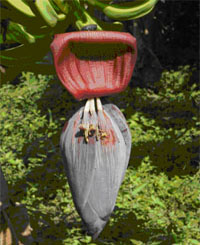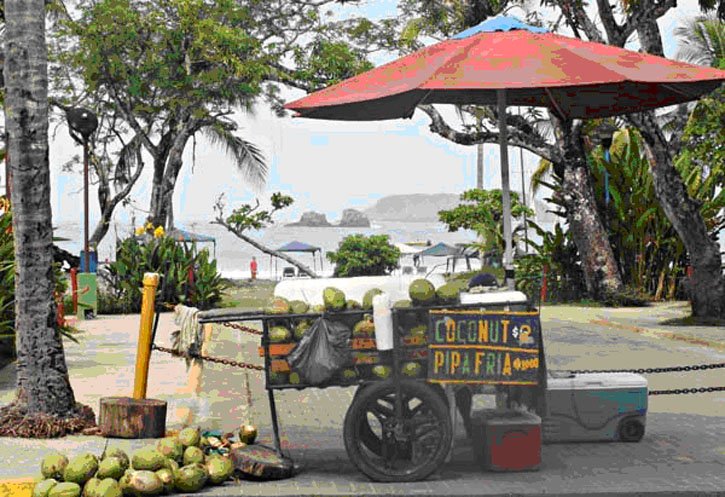|
|---|
Fresh Cold Coconut Water (Pipa Fria) From a Stand on Manuel Antonio Beach |
Broken News
(All the News That's Fit to Reprint)
How to Become a Saint
Almost everyone would agree, personal persuasions and beliefs notwithstanding, that the former pope two times back, John-Paul II, was a remarkable man. "The first skiing pope" one report blared shortly after he was elected. And Polish too, after hundreds of years of Italians.
I also remember the picture of him in the prison visiting and forgiving the man who tried to kill him and who nearly succeeded. It was also around this time that Hinckley made an attempt on Ronald Reagan. Both of these men worked together to bring the downfall of Communism and release hundreds of millions of people from that scourge. I was amazed at the physical and emotional strength of these two older men and their recovery from nearly fatal gunshot wounds. I am even more amazed now that I've reached their age.
 |
|---|
A Touchable Pope |
John Paul II was also the most traveled pope in history with 104 foreign trips. Who can forget all those newsreels with JP II exiting his airplane and kissing the ground no matter where he was, a practice of respect that became his trademark. That's a lot of tarmac mouth amigos. He logged over 750,000 miles (I wonder if that gets you platinum frequent flyer status with Alitalia). Folks in Costa Rica remember him as the only pope ever to visit tico land, which he did as part of a Central American tour in 1983.
The Vatican began the process of his canonization shortly after his death in April 2005. That ancient and slow process includes the requirement that two miracles, occurring after his death, be attributed to him. So it was with jubilation that Costa Rican catholics recently learned that the Vatican recognized as John-Paul's second official miracle something that occurred in Costa Rica to a lady named Floribeth Mora.
 |
|---|
Floribeth Mora |
Mora and her husband had been residents of Dulce Nombre, a small mountainous village in Cartago province where they started two businesses and raised four children. Mora claims a medical miracle saved her life after praying to John Paul who had not long been dead. She was diagnosed with an inoperable and fatal aneurysm, coincidentally the same medical problem John Paul had died of shortly before. After the discouraging diagnosis Señora Mora was sent home to die by the doctors
After praying to JP she heard a voice which said "get up". She only told her husband two days later thinking he would think her crazy. Instead, the husband reported he heard the same voice when he was praying while she was lying sick in the hospital, only with him it was "get her up". The next checkup with the doctors showed that the aneurysm was inexplicably and completely gone.
The miracle committee in Rome (I'm sure it has a more formal name), in cases of medical type miracles requires that the reported instance clear a team of doctors who must declare that the miracle recovery was "complete", "instantaneous" and "durable", i.e., lasting, no recurrence of the physical problem. After that it goes through a series of theological reviews before it lands in the pope's desk for final approval.
If you believe in these kinds of spiritual connections no further proof is necessary; if you don't believe, no amount of additional information will suffice. We report, you decide.
So amigos, if you want to become a saint, it all starts with making at least one visit to Costa Rica (yuk, yuk).
¡Dios Te Bendiga!
Monkey See - Human Do
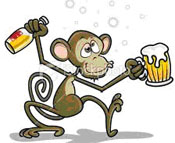 |
|---|
It is an axiom that men and apes have a common heritage. Evidently that also includes behavior when it comes to the use of alcohol.
The jungle and tropical forests here are replete with fruit that ripens and then ferments, giving animals the opportunity to sample fruits that produce mind-altering moments, even black-outs. Monkeys, of course, have the pick of the crop because they can swing through the trees and pick off the loaded fruit before it drops to the ground where the other animals can get at it.
 |
|---|
Another Heineken Please; Come Here Often, Babe? |
Now a U.C. Berkeley professor will be conducting field studies to measure the alcohol content of certain types of mangoes, a favorite food of monkeys (I suspect that Berkeley is a pretty good place to study the effects of alcohol). The prof and his team will be in the jungle for a year studying the alcohol content of mangoes and how some monkeys go about consuming them (please tell me this is not a government grant). Might this lead to MAA (Monkey Alcoholics Anonymous)?
 |
|---|
Another Study in the Making |
Anyone who's visited Manuel Antonio National Park knows monkeys are great thieves. Leave your backpack on the beach and while you're dipping in the ocean, more than likely some white-faced dudes (Capuchins) will be dipping in your backpack, even opening zippers to get at the contents. They're cute but they can be a nuisance so protect your stuff amigos (guards armed with a broom are a good idea).
There has been enough observation of the monkeys by scientists to note that there are patterns of similarity between the apes and humans. A rough count in one study of how those hairy swingers imbibe showed close to the same percentage breakdown of teetotalers, moderate drinkers and drunken sots as is prevalent in humans. One of the objectives of the study is to measure that very fact more precisely and try to relate monkey and human behavior in the hope that some of the knowledge might be used to help humans.
Good luck and cheers (hic), amigos.
GG is coming up on five years as a resident of Costa Rica and I've come to love the country and its people. I've also mentioned before in these columns the sometime difficulties we have in dealing with bureaucracy here (I minored in understatements at university). The whole tenor of what happens here is best summed up in the country's low ranking by the World Bank's "Ease of Doing Business" Index (see Easing on Down).
GG was diagnosed with cataracts last November and told to make an appointment for six months later. Somehow that got translated by the doctor's assistant into an appointment for October 22, 2013. By June my seeing and perception had deteriorated significantly (I'm now making many mistakes requiring endless corrections typing this and other articles). I asked my Spanish teacher to call the ophthalmology office to see if I could get the October appointment moved up. Jorge was told we had to go to the hospital where the doctor has his office (3 hour bus ride) and try to get included in the daily schedule - appointments are never made over the phone. We tried to do so on Monday, July 15 and, after waiting 4 hours were told we couldn't get in.
 |
|---|
There's Always Another Window |
The doctor's assistant referred us to the scheduling office that said the appointment for October couldn't be changed. That lady referred us to the Director of Nursing's office where we were told the same and that "you should be grateful for getting the October appointment". Really? By that time the devil in me was rising to maddening proportions. We started to leave, with me uttering expletives deleted under my breadth, when Jorge noticed a small office near the exit. He inquired there and retold the story for the fourth time. They listened - it turned out the office was an extension of the hospital director's office.
Eventually another lady emerged so Jorge had to tell the full story one more time. The new lady made a call and found she couldn't improve the appointment date either. She then asked "Do you need to keep the same doctor?". No says I (I'd like to adjust the eyesight of that other one anyway - didn't tell her that of course). Five minutes later I had an appointment to see a new doctor three days hence. She not only empathized but she asked me to write a letter to the hospital director about the incident.
When I thanked her and asked her what her name was she said "Señora Milagros". Milagro in Spanish means miracle, so you see, they still can happen.
Follow-up: Another trip to Puntarenas the following week produced, after more bureaucratic falderal, a referral to Hospital Mexico, the only place in the national health care system where they can actually do the cataract surgery. More to be revealed..
¡Pura Vida!
Rumble Talk
(Shaky Happenings On or About the Pacific Rim)
Is Arenal Really Sleeping?
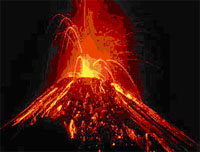 |
|---|
Arenal In a Past Display |
Anyone who has visited the Arenal volcano here knows it has been one of the most active, if not the most active, volcano in Costa Rica. At least that was the way it was up until a couple of years ago,
In recent months the famous lava displays have not been seen, This leaves people wondering if the volcano is sleeping and others wondering if it's building up pressure for a major squirt. Scientists (Observatorio Vulcanológico y Sismológico de Costa Rica) who monitor the cone say there is regular and continuing geothermal activity registering on their seismographs.
I suspect it's not wise to underestimate the power of potential destruction from something like Arenal.
Volcanoes May Scream a Warning.
 |
|---|
Sometimes I wonder who has the most people running around Arenal, tourists or scientists. Now a University of Washington study, in which Arenal played a significant roll along with some Alaskan volcanoes, has come to the conclusion that their may be a certain type of signal just before a volcano erupts.
The theory goes, and some scientific measurements have shown, that a flurry of small earthquakes usually precede a major eruption. These quakes come so frequent and together that they send out a "harmonic tremor" that approaches being like a musical signal. In essence the mountain is "screaming".
In Arenal's.case, the frequency is similar to the sound emitted from a clarinet. Other mountains give off similar signals but may vary in frequency.
Perhaps if we can get things together we could have a grand national symphony made up of the signals coming from the considerable chain of volcanoes running down Costa Rica's spine (see map).
Could I have a D-flat from Turrialba please?
| Check Out Recent Earthquakes Around the World Posted by the U.S. Geodetic Survey: Today's Quakes |
|---|
The Power of Pipa
(Coconut Water to the Rescue)
A favorite offering of street and beach vendors here is coconut water served right in the coconut.
On any day, purveyors of coconuts wander the beaches or the streets of metropolitan Quepos offering coconut water from freshly picked coconuts. Some vendors are fairly elaborate suppliers such as the one shown in the header picture of this edition. The gent with this wagon not only offers coconut water but he chills it (pipa fria), making it even more refreshing. Still others simply have a bucket of coconuts they picked a short time ago and offer the nut and its contents "au naturale".
Preparing a Coconut for Pipa |
|---|
 |
Now That's a Real Tico Machete |
 |
Missed His First Chop |
Coconut water in Costa Rica is also known as "pipa" . Why this is so is not clear (see What's-in-a-Word section below). Some think of pipa as the water of Costa Rica. Whatever you call it it has a very light, barely sweet or lightly tart (I can never decide which) refreshing taste, especially when chilled.
My understanding is that coconut water is becoming popular in the States and is now being offered by some of the major bottlers, such as Coca-Cola (marketed under the brand name "Zico"). Don't know how exact a replica this stuff is of the natural juice, but I suspect the natural nutrients of the bottled version change somewhat due to the necessity of adding stabilizers and anti-oxidants to facilitate storage and distribution.
The way you get to the pipa from the coconut is demonstrated in the video to the left. Just take your machete (what, you don't have a machete?) and start whacking thin slices of the coconut shell from the top until you make a small hole suitable for a straw. Be careful, don't do this at home, without extensive Tico training!
Note that the dude in the video, who I believe is not a Tico, is using a puny machete unlike the Tico dude in the lower picture who has a real macho machete. Most of the tico dudes I'm used to seeing at Manuel Antonio beach all use the larger machetes and often carry them onto the bus (no TSA here amigo). I'm amazed I've never seen a handless vendor or mangled paw, but they're good at what they do, even if a few of them here are also known as heavy imbibers.
It's easy for anyone to get into the pipa business as the raw materials are free and no investment is required in owning or leasing a building. The only equipment needed is a machete and a bucket. Just fill the bucket full of coconuts, grab your machete and walk along the beach or city streets plying your wares. There are literally hundreds if not thousands of coconut palms in the Quepos/Manuel Antonio area and each palm can produce 150 to 200 coconuts in a season. Each coconut holds 200 ml to 1000 ml (7-34 oz) of coconut water depending on its size and type.
Standard procedure when finished drinking the pipa is to ask the vendor to open up the nut with his machete so you can get at the meat. The vendor will give you a piece of the shell or a plastic spoon to scoop out the white stuff that in other countries you usually buy shredded in a market. Yummy.
 |
|---|
The Hard Part - Gathering Raw Materials |
 |
A Pipa Enthusiast |
Pipa comes from immature or green coconuts. Those brown, hairy devils you sometimes see in the supermarket are mature nuts. Their not as suitable for pipa because a chemical change resulting from the maturing process turns the water to coconut milk that is very fatty. Stick with the green nuts for pipa.
So, are there health benefits to pipa? Why yes there are Golden One ... many according to the literature. It is rich in amino acids, enzymes, dietary fiber, vitamin C and minerals such as potassium, magnesium and manganese; at the same time it is low in cholesterol and chlorides. This makes it ideal to maintain body fluids when a person gets dehydrated. The stuff is so beneficial to humans that it was used intravenously as a replacement for unavailable plasma in the Pacific theater during World War II.
Here are other reported benefits:
- replaces fluid and electrolyte loss after a bout of diarrhea
- rich in nutrients needed to control diabetes
- anti-viral and anti-bacterial properties help fight colds and flu
- high potassium content reduces risk of hypertension and stroke - pipa has about twice the potassium content of bananas
- in a matter of two to three weeks, it can clear acne, spots, wrinkles, stretch marks, cellulite and eczema, when applied topically and left overnight
With regard to that last one I couldn't let it go. For some time now I've been having what I call dry scalp. A quick web search by the GGC Technical Research Department (guess who that is) for the condition I described results in the possibility that the problem is a mild form of psoriasis. I wondered if pipa could have a beneficial effect. So I bought a two liter bottle of fresh pipa; yeah, that's right, two liters. Back calculating from the metrics above, on average it takes at least 15 coconuts to get that amount of liquid. I'm in the process of testing the topical treatment theory now - results in the Chronicles next month. ..
The one cautionary statement I came across during this research is that coconut water is high in sodium, so if you have a sensitivity to sodium, you should use pipa with caution. Another tip: drink it reasonably quickly after opening the coconut as oxygen slowly denutrifies the liquid (I wonder how they stop that from happening in the commercial version).
So come on down to the beach, sit under the umbrella with us and enjoy fresh pipa, any time of the year..
¡Buen Salud!
Going Bananas
(Or Is It Going Plantains?)
Bananas have been an important export crop for Costa Rica since the 1800's. The development of the banana industry here was initially intertwined with that of the railroad (see Choo Choo Chiquita).
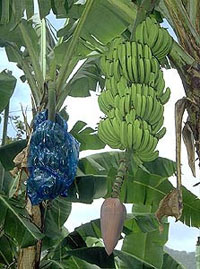 |
|---|
A Stem (or Bunch) of Bananas Ready for Picking (Right) and An Immature Stand Protected by a Blue Plastic Bag (Left) |
The banana industry was once the top export product for Costa Rica and in 2011 still represented nearly 10% of the $7.7 billion export trade here. For Costa Rica, banana exports still share the top three individual product positions along with medical devices and electronic components.
Bananas don't grow on trees as the axiom suggests. The banana plant is a perennial herb that winds around itself tightly at the base achieving a thickness up to 12 inches. It can grow to a height up to five meters (16-17 feet) and the stalk is strong enough to support the weight of the banana bunch, which is considerable. Each bunch or "stem" can have three or more tiers of fruit with up to 20 "fingers" on each tier. It's not unusual for a stem to weigh in at more than 45 kilos (100 lbs)..
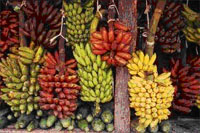 |
|---|
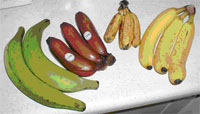 |
Several Types of Bananas. Left to Right: Plantain, Red, Finger and Cavendish |
Buying bananas in the U.S. usually means buying them green or store-ripened. Not so here. In fact it's often difficult to find a green banana in a market here - and when you do, more than likely it's really a plantain. The good side of buying fresh fruit here is that the fruit is richer when ripened naturally; the bad side is it doesn't last long so buy only what you need for today or tomorrow.
There are many types of bananas, some say there are hundreds of varieties, but only a few are routinely commercial. The most common commercial variety is called Cavendish and takes that moderate-sized crescent shape most gringoes will recognize (see What's-in-a-Word section below about this spelling of, gringoes) . There might also be, however, bananas that are red or purple, and small varieties called "finger" or "lady finger" that are exceptionally sweet. And, of course the venerable plantain, which can be much larger than the Cavendish.
Each banana plant produces only one stem of bananas per year. Unlike many plants banana plants are not pollinated. If they do get pollinated the resulting fruits are full of seeds and void of pulp. Instead it's the female flowers which appear first and these give way to the fruit after the flowers stand a long time without pollination. So the male flowers have no part to play in making bananas (sometime GG feels that way). A new banana plant takes 10 to 15 months to flower and 3 to 6 months to produce fruit after that.
The pictures below show the various stages in the growth of a banana bunch. First the female flowers bloom (1) and then the fruit pushes out of the flowers (2). The early and small fingers (3) actually point downward but eventually reverse themselves to point upwards (4).and eventually the bunch grows to harvest size (5). In the last stages of growth, the stem is usually covered with a plastic bag, typically blue in color. This helps the fruit to ripen more quickly while protecting it from insects that can detect ripening fruit.
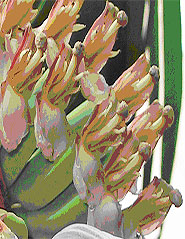 |
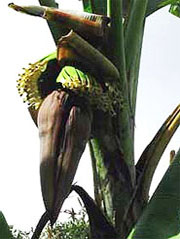 |
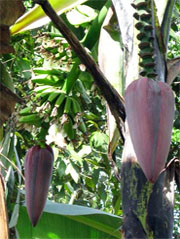 |
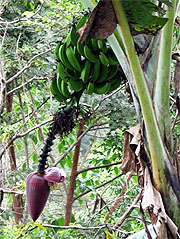 |
|---|---|---|---|
1. Female Banana Flower |
2. Bananas Forming from Female Flower |
3. Young Bananas Pointing Down |
4. Older Bananas Pointing Up |
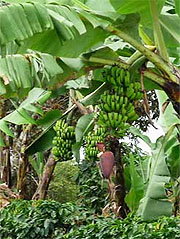 |
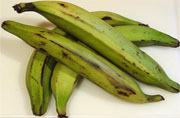
|
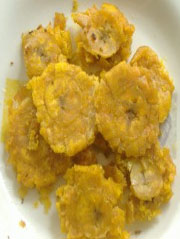 |
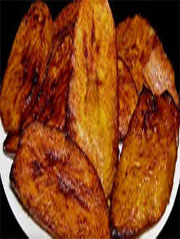 |
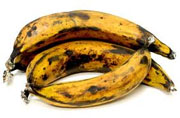 | |||
5. Bananas Ready for Harvesting |
Plantains - Green (top) and Ripe (Maduros) |
Patacones from Green Plantains |
Maduros Fried in Butter |
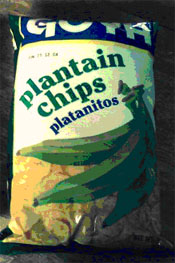 |
|---|
So what's different about plantains? Not a hell of a lot actually, except they're larger (sometimes 2 to 3 times a Cavendish), firmer (even hard when unripened) and not as sweet when green. As one reference put it: "there is no real cultivar difference". Unripe green plantains are often cut into disks and fried crisp; these are called "patacones" (pah-tah-ko-nays). Patacones are rather tasteless in my opinion but they are often served with dips or mayonnaise or some kind of spread like refried beans, which makes them more interesting.
Plantains can also be processed into "chips" and sold in bags like potato chips, a favorite snack for Ticos. Ripe plantains, called "maduros", are softer and sweeter than their green brethren (sisters?). Fried in butter they make a wonderful accompaniment to a meal and are often on a casado plate, a typical Tico full lunch or dinner consisting of a modest amount of meat or fish, rice, beans, shredded cabbage or salad and probably one other starch such as pasta shells.
So bananas and plantains are more examples of the richness of the tropics. But one song you'll never hear them singing here is: "♫Yes , we have no bananas..♪".
¡Solo Bueno!
Reptile Shenanigans
(What a Croc This Is)
Almost everyone knows, or should, that Florida has alligators and Costa Rica has crocodiles.
The difference between the two is not horrendous. Alligators have a rounded snout, crocodiles a more v-shaped head. Alligators expose one set of teeth pointing down when their jaw is closed; crocodiles have both up and down sets of overlapping teeth they can show. Crocs are, on average, larger and heavier than gators. Other than those features, both reptiles are part of the "crocodilian" family, sorta like the bananas and plantains thing. Scientists tell us that crocodilians have been around continuously for 240 million years outlasting dinosaurs by 65,000,000 years. Tough dudes,eh?
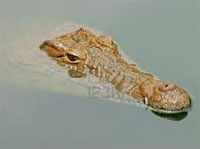 |
|---|
Hola Amigo, Let's Do Lunch |
On one of my first visits here, I was walking north along Manuel Antonio beach (actually Playa Espadilla) when I saw an area at the base of the mountain that served as a catch basin for water runoff before it ran into the sea. It was a sizeable pool; Floridians would call it a "lake", New Englanders a "pond". It seemed promising for inspection so I began to walk toward it only to be brought up short by a concerned Tico who said: "No, señor, hay cocodrilos". Sure enough, on closer examination (but not too close), there it was, a sizeable crocodile slowly plying the water with only the top of his head showing. He was barely making a ripple. Later I learned that this location had seen the demise of several domestic pets that got too close. I walked around the pool giving it wide berth. Ah, life in paradise.
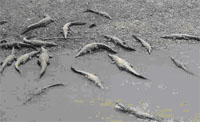 |
|---|
Crocs at the Tarcoles |
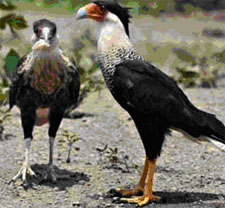 |
|---|
Crested Caracara Buzzards Waiting for Scraps of Any Kind |
Recently, some friends visited and when we drove back to Quepos from San José airport we stopped some miles above Jacó at the bridge that crosses the Tarcoles river (official name - Rio Grande de Tarcoles). This has become a favorite tourist stop because there you find numbers of crocodiles, sometimes even several dozen, congregating on the muddy river banks below the bridge. We were not disappointed that day as I counted 22 crocs basking in the sun just below the bridge. Reportedly, there are hundreds in the vicinity.
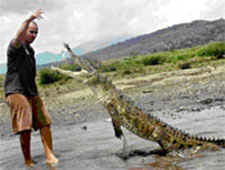 |
|---|
Crazy Jimmy Giving a Chicken Snack to a Croc |
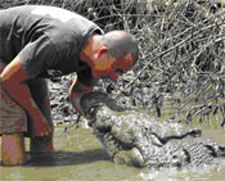 |
Kiss Me Baby, I Love You Too |
Not surprisingly, this river is not a favorite swimming hole. Yet there are people who like to take their chances.with crocodilians. One of them is a fellow who people have dubbed "Crazy Jimmy" because of his penchant for jumping out of the tour boat on which he serves as a guide in order to play with and even embrace the crocs.
What can I say, some guys use fast cars to get a thrill, Jimmy plays with 15 foot, 2,000 pound reptiles.
Jimmy works for "Jose's Crocodile River Tour" based at the Tarcoles. He tempts his reptilian friends with chicken pieces which he feeds like someone who's giving a treat to a dog. He even smooches one of the reptiles like it was a pet schnauzer. Don't believe me, just check out the pictures to the left.
What we have been reporting thus far is the species called the American Crocodile. Although they can range up to 5 meters (16+ feet) and 1,000 kilos (2,200 lbs), they are not the biggest in the world.The size winners and the record go to the African croc. The African croc exists not only in Africa but in the Philippines as well. A recent capture in the Philippines is believed to be the current world's record (yet to be confirmed by Guinness and others).
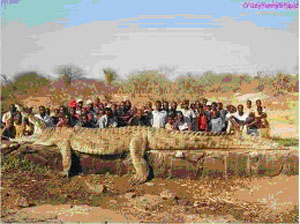 |
|---|
| "Lolong" Being Admired by Locals |
The Philippines croc, which was named "Lolong" by the locals became the focus of a search after it reportedly attacked several people, killing two. After a three week manhunt (er, croc-hunt), Lolong was captured, weighed and measured.
Lolong measured 21 feet (6.4 meters) in length and weighed in at 2,169 pounds (1,075 kilos or just over 1 metric ton). These were the figures given in the press report but something's wrong because 2,169 lbs is 985 kilos and 1,075 kilos is 2,368 pounds. My guess is the 1,075 kilos figure is right. (Once an engineer, always an engineer)
There was a report that stated Lolong actually survived capture - oh, really, you mean they measured this dude alive? The picture of Lolong above tells it all. I guess those are real, average size people flanking the monster.
My, what a croc this is.
¡Pura Vida!
What's-in-a-Word
Pipa (pee-pah)
As mentioned above, it's not clear why latinos call coconut water "pipa", The word in Spanish actually means "pipe" like a water pipe or smoking pipe. According to my handy-dandy online dictionary the word can also take on the connotation in Spanish of "cask" or "reed". That makes it clear, right? (not)
The word does have other meanings around the globe, to wit:
-
China - A pipa here is a popular four-stringed instrument that has been played in China for over two thousand years (makes a Stradivarius look new, eh).
Pipa Pipa Frog -
In Old English the name is associated with "pippa" which means "horse lover".
-
In some native cultures pipa can also mean "baby girl".
And then there's the Suriname Toad, also known as the Pipa Pipa Frog. This rather ugly little creature is found in certain eastern regions of South America like Bolivia, Brazil, Colombia, French Guiana, Guyana, Suriname, Trinidad and Tobago.
So there we go, we have another Spanish word of dubious origin and flexible usage. No problem for GG as long as I can get coconut water when I order it.
Platanos
The history of bananas and plantains in the Caribbean has been traced to the activities of a Portuguese Franciscan Monk who introduced it to the Caribbean island of Santo Domingo in the 1516. He had first come in contact with the fruit in the Canary islands, where it had, in turn, been brought by other Franciscan compatriots about a hundred years earlier. The plants came originally from Malaysia and Indonesia,
The word itself seems to be a fusion of the Old French plaunteyne and the latin plantāgō.
Gringoes
You may have noticed that in the article on bananas and plantains that GG used the form gringoes for the plural of gringo. Most of the time I've seen it written as gringos (even my online dictionary uses this form). Wanting to achieve the best english grammar possible, and rarely reaching that goal, it occurred to me that if potato and tomato become potatoes and tomatoes in the plural form, so should gringo become gringoes. So let it be written, so let it be done. (see what happens when you're retired and have too much time on your hands).
ROMEO Corner
(Retired Old Men Eating Out)
Ronny's Place
Location: From Quepos take the main Manuel Antonio until just past Hotel Gaia. Turn right on he unpaved road across from Amigos del Rio - it's on the left at the end of the road (about 1/2 mile).
Hours: Sunday to Saturday from 12:00 PM to 10:00 PM (Saturday and Sunday, reservations are suggested)
Parking: Ample at the restaurant.
Contact: Tel.: 2777-5120; Email: info@ronnysplace.com; Website: http://www.ronnysplace.com/
Reviewing ROMEOS: Anita M., Tony R., Brian M., Bob N.
To Review Our Rating System and Procedure, go here: R.O.M.E.O. Rating System
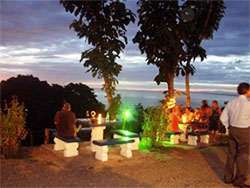 |
|---|
| Outdoor Tables at Ronny's Place |
This is one of the longest standing restaurants in Manuel Antonio and it's still one of the most popular. It boasts one of the best views one can have of the Pacific Ocean from Manuel Antonio.
We got there at 5 PM to take advantage of the sunset (it goes down by 6) and by the time we left, the restaurant was nearly full even though it was Wednesday and we were well into the rainy season. Luckily, the rain that evening passed north of us and we were able to sit outside the entire evening in full panoramic view of the sunset and the Pacific.
In addition to the outdoor tables, the restaurant has a pleasant, covered dining room appointed in natural woods and softly lit.
For atmosphere it has to be five sloths (despite the cement seats outside).
The menu offered an eclectic mix of everything from pastas to typical rice dishes, large salads and several versions of "Mar y Tierra" (Surf and Turf) plus a smattering of Mexican fare such as burritos . There were also several versions of brochettes that were based on chicken, beef or fish. Three ROMEOS ordered brochettes and one had a burrito. GG's brochette was of large pieces of chicken, sweet pepper, onions and pineapple and was bathed in a mild caribbean style sauce. The brochette was de-skewered when served, a small detail appreciated by the gilded one (I hate fighting those skewers). It was accompanied by plain rice (my request), a medley of steamed vegetables and a finely diced piccadillo of cooked carrots. All the ROMEOS reported the food as fresh and tasty (mine was a bit cold). Four sloths for food quality. |
 |
|---|---|
$ $ $ $ |
|
Value Index = 4/4 x 100 = 100 |
The young man who served us was pleasant and responded well to our requests. The kitchen, not unlike many here, was a bit slow but not excessively so and the view and good conversation does take your mind off the cooking time. Four sloths for service and an overall rating for ambiance, food quality and service at the same level, four sloths.
None of the ROMEOS had appetizers. My dinner and a soft drink came to just over 9,000 colones ($18) putting the restaurant in the high four dollar rating range compared to others in this area. That gives Ronny's Place, in our opinion, a Value Index of 4 sloths/4 dollars x 100 or 100 which puts in in the middle of all the restaurants we've reviewed so far.
Ronny's Place offers a pleasant dining experience and, if you can manage to be there on a rain free evening, you will also be treated to a stunning Costa Rican sunset.
don Beto de Quepos, El Gringo Dorado Pura Vida! |
Be pithy but kind. I'm sensitive. |
|---|
